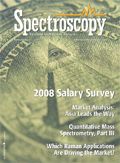Spectroscopy: A Technology for All Seasons
Spectroscopy techniques are an important facet of the laboratory analytical and life science instrument industry, which continues to expand as its analytical requirements migrate across industries and geographic regions. Overall industry growth has been in the 6-8% range for the last few years, which is a sign of both its maturity and its stability. The demands of the life science marketplace, environmental concerns, and the search for new materials are important driving forces. Likewise, the shifting market focus from North America and Europe to Asia is changing the face of the industry. It is expected that 2008 will be a good year for the industry despite the likely economic slowdown in North America and Europe.

According to Instrument Business Outlook (IBO), a publication of Strategic Directions International, Inc. (SDi), a consulting and market intelligence firm specializing in this market, the total worldwide market for analytical and life science instrumentation and related aftermarket and service revenues was estimated to have exceeded $35 billion in 2007. This represented an overall increase in industry revenues of about 7.0% from 2006, which was somewhat of a surprise given the outlook at the beginning of 2007. The specter of a recession in the United States and a more modest economic slowdown in Europe is a pause for concern, but continued growth in developing countries, especially China and India, should be a countervailing force, particularly if domestic demand in those countries can compensate for reduced export growth.
Of course, we still must endure the burden of high petroleum prices, Middle East turmoil, and the distraction and future consequences of political change in America and other countries. Nevertheless, opportunities related to continuing demand for commodities such as copper, aluminum, steel, and oil, as well as some renewed strength in the pharmaceutical sector for technology expenditures, should help to offset some global negatives. With all this in mind, SDi projects a slightly lower overall industry revenue increase in 2008 of 6.4%, which is still within the narrow range of growth experienced during the last two years.
In 2007 it became clear just how important Asia is to the industry. The market in China expanded dramatically, and for some companies it is now their single largest market after the U.S., and growing two to three times as fast. Japan was a disappointment last year, and difficulties in that economy suggest that 2008 will be no better. The European market generally was more robust than North America, although currency exchange rates added uncertainty to economic prospects while affecting supplier financial reports both positively and negatively based on manufacturing locations.
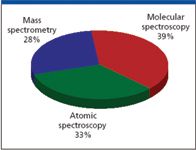
Figure 1: 2007 spectroscopy market by sector ($7.8 billion).
Major events of 2007 included the acquisition of Strategene (La Jolla, California) (polymerase chain reaction) and Velocity11 (Menlo Park, California) (laboratory automation) by Agilent Technologies (Wilmington, Delaware) (mass spectrometry [MS], high performance liquid chromatography [HPLC], gas chromatography [GC]), which was a reaffirmation of Agilent's desire to be more deeply involved in the life science market; MDS Sciex's (Concord, Ontario, Canada) (MS) purchase of Molecular Devices (Sunnyvale, California) (microplate readers) for similar reasons; and the final formation of a publicly traded Bruker family of companies with the merger of Bruker Biosciences (optics, X-ray, and MS) and Bruker Biospin (both in Billerica, Massachusetts) (nuclear magnetic resonance [NMR]). We also saw much more focus by industry participants on the applied markets of food safety, forensics, and environmental testing. These companies also benefited from their involvement in the petroleum processing and petrochemical markets.
There is also a growing interest in the aftermarket aspect of the industry revenue mix, which includes such areas as consumables, software updates, and accessories. This is in recognition of the growing importance of those areas as the market expands and matures. In fact, in some market segments, the aftermarket is growing faster than instrument system revenues and is often more profitable. So it should be noted that all the revenue projections in this article include the total mix of revenue sources: instrument system sales, aftermarket, and service.
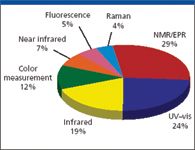
Figure 2: 2007 molecular spectroscopy market by technique.
The spectroscopy market can be segmented into three distinct sectors: molecular spectroscopy, atomic spectroscopy, and MS. The applications of the techniques included in each sector and their prospects differ significantly, even within each sector. Worldwide revenues for all spectroscopy segments is estimated at $7.8 billion for 2007, or about 22% of the entire laboratory analytical and life science instrument market. The overall spectroscopy market is estimated to have grown 7.6% in 2007, slightly more than what we forecasted last year. SDi projects 2008 spectroscopy market growth to be moderately lower than for 2007, increasing at about 6.7%. This is a function of some of the hotter markets cooling down and a projected global economic slowdown. Still, the spectroscopy market is projected to grow faster than the remainder of the laboratory instrument market, which is a continuation of the pattern for the last three years.
Molecular spectroscopy techniques account for about 39% of the spectroscopy market, although many diverse techniques are represented that address a wide range of applications in almost every industry category. Atomic spectroscopy is the second largest sector at almost 33%, while MS represents slightly more than 28% of spectroscopy revenues. Please note that LC and GC front-ends to mass spectrometers, and their associated aftermarket and service revenues, are not included in this analysis.
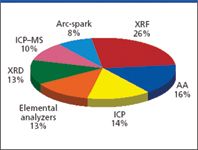
Figure 3: 2007 atomic spectroscopy market by technique.
Molecular Spectroscopy
The market for molecular spectroscopy is estimated to have reached $3.1 billion for 2007. Overall, the total revenues for all categories of molecular spectroscopy grew 6.3% last year. However, growth rates differ measurably for the various instrumental techniques, led by the continuing success of the NMR segment, while fluorescence spectroscopy is expected to experience the slowest growth. No single technique dominates this market, although the NMR and UV–vis product segments account for over 50% of the overall molecular spectroscopy market.
Molecular spectroscopy instruments are especially focused on the important life science industries, including pharmaceutical, biotechnology, and the agriculture, food, and beverage industries, which now account for about 35% of the market. Organic chemicals, academia, and government sectors account for an additional 30% of revenues, much of which is also life science–oriented. But molecular spectroscopy techniques have an enormous range of applications, so they can be found in every industry segment, including environmental testing and polymer manufacturing.
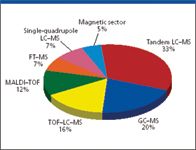
Figure 4: 2007 mass spectrometry market by technique.
NMR is one of the highest performance analytical methods commercially available to scientists, and it rivals high-end MS in many respects. The demand for such high-end capabilities seems to have no end, which will help to continue the nearly 10% growth in NMR expected once again in 2008, despite the fact that this segment of the market will account for nearly $1 billion on its own. The ever-increasing strength of the superconducting magnets used in NMR, which correlate strongly with cost, is one of the key drivers in the rampant growth of this market. But so too is demand for NMR probes, which can significantly improve the performance of older NMR systems, of which there is a fairly large installed base.
The NMR market is comprised of a number of related instrument types, including high-field NMR, hyphenated NMR, low-field (fixed magnet) NMR, imaging NMR, and electron paramagnetic resonance (EPR). High-field NMR and hyphenated NMR (mostly LC–NMR) are pharmaceutical and biotech oriented with a focus on structural analysis. Low field instruments are designed for quality control applications, especially for moisture and fat content analysis in foodstuffs. NMR imaging systems are applicable in clinical and biotech settings for combined imaging and spectral analysis of samples and organisms. There is also renewed interest in the development of mid-range instruments as lower cost alternatives to expensive ultra-high performance instruments, but with significantly better resolution than existing conventional 300 MHz instruments. EPR is a useful technique for the analysis of free radicals, transition metals, and material defects. High-field NMR is by far the largest segment of the market.
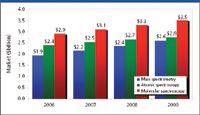
Figure 5: Spectroscopy market by product segment ($ billion).
Demand for conventional fluorescence spectroscopy, and to a lesser extent UV–vis spectroscopy, continues to be siphoned off by microplate readers that can perform either, or in some cases both, of these analyses on a single platform. Unlike the remainder of the fluorescence market, which consists significantly of niche products, a very large portion of the UV–vis market is made up of photometric colorimeters that are used very heavily in water and environmental monitoring applications. There has been a significant surge in activity in these industries, which is contributing most significantly to the expected growth in the UV–vis market, somewhat offsetting weaker areas of the market.
The market for color measurement is similar to but quite different from conventional UV and visible spectrophotometers. It is almost entirely disconnected from other molecular spectroscopy markets based on the suppliers participating in the market, and the end-users and their applications. Color matching of paints, textiles, and automotive body finishes is a major application, so portability is an important feature of these instruments. Growing applications include digital imaging, printing, and graphics, and even instruments that aid in tuning high-definition television sets. The color measurement market has seen significant consolidation and is now dominated by X-Rite (Grand Rapids, Michigan), with well over 50% market share. The top three competitors now account for over 80% of global sales. Despite the expected economic slowdown and likely weaker sales of color measurement products to consumers, the laboratory and industrial side of the market should be largely insulated from a downturn.

Figure 6: Estimated growth by spectroscopy sector for 2008.
The near infrared (NIR), IR, and Raman spectroscopy markets are all experiencing significant shifts toward alternative design configurations that diverge markedly from conventional laboratory benchtop systems. While some microplate readers can now perform these spectrometric measurements, these instrumental techniques will be largely unaffected. Another important trend is the movement toward on-line applications using remote sensors, especially fiber optics, especially for NIR and Raman, since these techniques are quite adaptable to these applications. A third trend is the focus on handheld Raman and NIR instruments for security applications and on-site polymer analysis.
Atomic Spectroscopy
The market for atomic spectroscopy instruments is experiencing steady growth and is predicted to expand about 4.7% in 2008, only a slightly lower pace than experienced during the last few years. However, within this $2.5 billion market, growth varies widely for the techniques included. Market demand for atomic spectroscopy instrumentation has especially benefited from the increased global demand for minerals and metals and their concomitant high prices, as well as by recently enacted environmental regulations. These positive market forces do exhibit different influences based on the capabilities and usefulness of individual spectroscopic methods. In addition to application-based market forces, the expanding markets in China, India, and other emerging market countries are shifting the regional demand that suppliers wish to emphasize.

Table I: Spectroscopy product growth prospects for 2008
X-ray spectroscopy has been a major growth segment for the last two years, especially X-ray fluorescence (XRF) and X-ray diffraction (XRD). Combined, these two techniques represented more than $1 billion in 2007 revenues. XRF continues to benefit from hazardous substance regulations and related types of analysis. This regulatory climate has stimulated the meteoric rise of handheld XRF instruments, which have moved far beyond the traditional XRF applications in metals analysis into the broader area of consumer product testing, driven by concerns about, for example, lead in Chinese-made toys. However, we are now seeing a leveling off in demand for these handheld instruments and accelerated growth in higher-performance benchtop systems as the application requirements evolve.
In contrast with XRF, XRD remains largely a laboratory technique. Here the growth has come mainly from product innovation combined with a shift in applications from primarily materials science to life science. XRD is crucial to life science research because of its use in studying protein structures as well as crystalline forms of drugs and other biological molecules of interest. Through the introduction of advanced X-ray sources and detectors, the capabilities of XRD instruments are expanding: they can perform more sophisticated analyses in a shorter amount of time. This increase in productivity naturally comes with an increased price tag, fostering the fastest growth among the atomic spectroscopy techniques.
Apart from the X-ray techniques, the greatest growth will be experienced by inductively coupled plasma–mass spectrometry (ICP-MS), with growth in the 6–7% range for 2008. Environmental concerns are the main driver. ICP-MS is the most sensitive atomic spectroscopy technique, allowing analyses at the part-per-billion and even part-per-trillion level. Changes in environmental regulations typically have been increasingly restrictive of allowable levels of particular elements such as arsenic. Many countries' regulations are now so stringent for particular elements that ICP-MS is the only practical method of analysis. Similarly, elemental analyzers, those instruments that quantify a small number of specific elements, are also benefiting from environmental regulation. Furthermore, because these instruments are highly specialized, they cater to a wide variety of very particular applications in many industries. Total organic carbon (TOC) analysis is one of the most important of these techniques and has wide application in pharmaceutical and semiconductor laboratories and facilities, as well as for drinking water analysis.
The market for atomic absorption (AA) instruments is expected to remain flat this year. This actually represents an improvement over last year, which saw a modest decline in the market. China, India, and other industrializing nations continue to be a source of growth for the AA market, while the traditional regional markets continue to be problematic. Lower cost AA instruments are particularly well suited to these emerging markets. The situation is slightly better for other varieties of optical emissions spectroscopy: arc-spark and ICP. Both of these techniques should experience low single-digit growth for the year. Arc-spark's primary application is metals analysis but for primary metals production and recycling. Demand for these instruments has shifted markedly from North America and Western Europe to emerging markets, especially China.
Elemental analyzers are specific-purpose instruments for the analysis of a limited number of elements. These instruments fall into two broad categories: organic analyzers and inorganic analyzers. Organic analyzers include TOC, CHN and protein, and sum parameters analyzers (total and bound nitrogen and extractable organic halogens). Inorganic analyzers are used for carbon–sulfur determinations and for mercury, arsenic, boron, and cyanide analysis. Organic analyzers, especially TOC analyzers, continue to exhibit much higher growth potential than inorganic analyzers. Pharmaceutical and semiconductor water analysis, as well as food-related applications, drive this market, while metals composition and trace metals analysis are key application areas for inorganic analyzers. While organic analyzers have enjoyed good growth for a number of years, recent interest in metals analysis has given new life to this mature technique.
With historically strong positions and broad product offerings, Thermo Fisher (Madison, Wisconsin) and PerkinElmer (Shelton, Connecticut) remain safely in the top two positions in overall market share. However, the increasing importance of the X-ray techniques has elevated companies primarily involved in XRF and XRD, namely PANalytical (Natick, Massachusetts), Bruker, and Rigaku (The Woodlands, Texas). Varian (Palo Alto, California) is also an important supplier of AA, ICP, and ICP-MS instrumentation. Spectro Analytical (a division of Ametek, Mahwah, New Jersey) is the leading supplier in arc-spark, while in the variegated world of elemental analyzers, LECO (St. Joseph, Missouri) remains the top company, with Shimadzu (Columbia, Maryland) and Horiba (Edison, New Jersey) as its main competitors.
Mass Spectrometry
For many years now, the MS market has been the growth leader in spectroscopy as the technical performance of various MS products keeps pace with the progressively more challenging analytical applications in the laboratory. The worldwide market for MS neared the $2.2 billion mark in 2007 as revenue growth exceeded 11%. This rapid expansion is expected to continue in 2008. The popularity of MS is clearly a function of its utility. Scientists also are taken by the plethora of exciting new product introductions that promise greater sensitivity, speed, and throughput, and for some products lower prices are hard to resist.
Most areas of the market will continue to see very strong growth in popularity. The continued investment in research and development by both the private and the public sector for analytical technologies is helping to continue the fairly steady trend in performance improvements in MS. While it is not certain which MS techniques will become the future leaders as a result of technological breakthroughs yet to come to fruition, it is fairly certain that the overall category will remain one of the premier analytical groups for years to come.
While the pharmaceutical industry will remain the bread and butter of demand for most MS techniques, biotechnology demand will continue to significantly outpace that of the traditional pharmaceutical segment. Demand from secondary industries for MS, including agriculture and food, environmental testing, and petrochemicals, has surged as of late, and that trend is expected to continue into 2008. While this demand surge in the food, environmental, and petrochemical sectors will, to some extent, benefit all segments of the MS market, it will clearly have the most impact on the GC–MS market, which should see very strong growth as it has for the last two years.
As expected, Agilent Technologies' 2006 entry into the triple-quadrupole and quadrupole time-of-flight (Q-TOF) segments of the market has had a major impact on much of the landscape of the MS market. This was especially evident in the triple quadrupole marketplace, where Agilent quickly surfaced as a formidable competitor, capturing market share and attracting new customers for this important technology, while adding fuel to the fire for the tandem LC–MS market. Agilent's involvement, coupled with strong responses from other suppliers, will contribute to achieving double-digit growth for the tandem LC–MS and LC–TOF market.
Within the tandem LC–MS market, the triple-quadrupole segment will dominate in 2008, in terms of both size and growth. However, demand for ion trap–based spectrometers also will see nearly double-digit growth, and will be characterized by a shift from conventional three-dimensional mass analyzers to the more innovative two-dimensional and three-dimensional designs that provide more efficient ion trapping capabilities and improved performance.
Single-quadrupole LC–MS instruments are growing in popularity because they carry lower price tags than tandem LC–MS units and can address routine applications for quality control and environmental analysis very efficiently. Improved mass detectors, as well as the coupling of new generation fast LC systems, increase sensitivity and speed of analysis. Although the matrix-assisted laser desorption ionization (MALDI)-TOF market has settled into a lower level of steady growth, it continues to find favor among various customer groups, especially in the biotech and clinical fields. Magnetic sector is the exception in the MS market, exhibiting minimal to flat growth in demand, but it is still the preferred technique for specialized applications such as isotope ratio analysis for drug scanning and geological applications. GC–MS should benefit from increased opportunities in the petroleum and petrochemical industries as well as from environmental initiatives.
The Fourier transform (FT)–MS market is trending toward mainstream status, and this should continue in 2008 thanks to the efforts of Thermo Fisher Scientific and its very successful LTQ-FT, first introduced in 2002, and the even more wildly popular LTQ-Orbitrap, which hit the market in 2005. These systems have not only spurred the development of tandem FT-MS systems with ion trap or quadrupole front-ends, and now account for most of the segment's sales, but they have also brought far more attention to the category. This excitement has also benefited other suppliers, including Varian (which now owns the IonSpec) and Bruker Daltonics.
Although the development of FT-MS has rendered the method far more accessible to a broad swath of scientists, pitting it more directly against Q-TOF MS, demand for Q-TOF continues to experience robust growth, due in part to continued technological advancements, such as Waters' (Milford, Massachusetts) ion mobility enhanced instrument, the HDMS Synapt. The combined growth of the FT-MS and Q-TOF markets demonstrates that there is still an enormous appetite for high performance MS.
Spectroscopy Continues to Be the Preferred Solution to Analytical Challenges
Every day, a new challenge pops up in laboratories around the world, and more often than not, spectroscopy comes to the rescue. Handheld and benchtop XRF instruments have been helping to reduce lead contamination of waste disposal sites and nearby groundwater for the last two years, and now the presence of lead in toys looks to this technology as a readymade solution. Atomic absorption spectroscopy has been declining in recent years as other techniques such as ICP, ICP-MS, and XRF have offered advantages such as higher sensitivity and faster analysis, albeit at a price. But now the burgeoning applications in emerging markets in Asia and Eastern Europe have given new life to this reliable technology.
Likewise, the race between HPLC and mass spectrometry as to which is the fastest has led to LC–MS instruments that offer both speed and sensitivity not dreamed of just a few years ago. Such performance can now provide drug development scientists with information in a more timely manner and at a resolution level that engenders confidence. And we must not forget the important structural information that new generations of NMR, X-ray, and MS systems offer to these same challenged developers.
China and India have now become markets of major interest to mass spectrometer manufacturers as demand soars in those two robust economies. In China, the rapidly expanding petrochemicals industry, coupled with a genuine interest in improving environmental quality, has been a boon to the GC–MS instrument market. China is now one of the top markets for this technology. India, on the other hand, represents an outstanding opportunity for LC–MS instruments in support of its growing pharmaceutical and biotech industries. India was once a market known only for generic drug production, but now it is becoming a location for new drug development as well. China also has made progress in these activities.
Portable mass spectrometers, handheld UV–vis, and NIR instruments are also providing emergency response personnel, military forces, environmental engineers, and industrial QC inspectors with the technologies to take the analysis to the location instead of taking the sample to the laboratory, saving time, expense, and perhaps lives as well. Miniaturization, clever packaging, and attention to customer needs have enabled spectroscopy manufacturers to deliver solutions that are making big differences in today's dynamic business, social, and political community.
So the saga continues. New techniques, new markets, and expanding applications all drive innovation, resulting in a growing use of spectroscopy-based technology worldwide and year-round, and perhaps for decades to come.
For more information on Instrument Business Outlook or other instrumentation research, contact Strategic Directions International, Inc. 6242 West-chester Parkway, Suite 100, Los Angeles, CA 90045, (310) 641-4982, fax; (310) 641-8851, E-mail: sdi@strategic-directions.com
Lawrence S. Schmid is President and Chief Executive Officer of Strategic Directions International, Inc., Los Angeles, California.
LIBS Illuminates the Hidden Health Risks of Indoor Welding and Soldering
April 23rd 2025A new dual-spectroscopy approach reveals real-time pollution threats in indoor workspaces. Chinese researchers have pioneered the use of laser-induced breakdown spectroscopy (LIBS) and aerosol mass spectrometry to uncover and monitor harmful heavy metal and dust emissions from soldering and welding in real-time. These complementary tools offer a fast, accurate means to evaluate air quality threats in industrial and indoor environments—where people spend most of their time.
New Study Reveals Insights into Phenol’s Behavior in Ice
April 16th 2025A new study published in Spectrochimica Acta Part A by Dominik Heger and colleagues at Masaryk University reveals that phenol's photophysical properties change significantly when frozen, potentially enabling its breakdown by sunlight in icy environments.
Advanced Raman Spectroscopy Method Boosts Precision in Drug Component Detection
April 7th 2025Researchers in China have developed a rapid, non-destructive Raman spectroscopy method that accurately detects active components in complex drug formulations by combining advanced algorithms to eliminate noise and fluorescence interference.
